You can enjoy many kinds of pasta while following the low FODMAP diet, including many Asian noodles. This article is All About Asian Noodles & FODMAPs in particular.
Asian Noodles vs. Italian Pasta
Growing up in the U.S. most of us are familiar with pasta made from wheat and semolina. Semolina is a flour made from durham wheat and is used to make many of the traditional wheat-based pastas that we have always used.
Brands like Ronzoni and Barilla are made with semolina/durham wheat, as example, and if you are eating classic spaghetti with marinara sauce or lasagna, then you are eating that type of pasta.
Asian noodles are quite varied and can be made from wheat, rice, buckwheat, even sweet potato, and some can even include egg.
Asian Noodles Tested by Monash University
Monash has tested the following – and I have included their recommended serving sizes:
Wheat Noodles (which look like ramen in their app image, and seen below): No low FODMAP serving size is recommended. Even just ½ cup (84 g) cooked showed fructan and fructose content. As a point of interest, traditional wheat pasta does have a low FODMAP serving size of ½ cup (74 g) cooked.
Vermicelli Noodles (which look like rice-based in their image): Low FODMAP serving size is 1 cup (113 g) cooked. The small print notes that the serving size is low in FODMAPs. This is presumably due to the fact that they are based on “no” FODMAP rice. Below you can see our friend Ngoc making our low FODMAP Summer Rolls with vermicelli noodles.
Kelp Noodles: Low FODMAP serving size is 1 cup (113 g) cooked. The small print notes that the serving size is low in FODMAPs.
Rice Stick Noodles: Low FODMAP serving size is 1 cup (220 g) cooked.
Soba (made from wheat & buckwheat, seen below): Low FODMAP serving size is ⅓ cup (90 g) cooked. The small print notes that the serving size is low in FODMAPs.
Also please see in our images below that 90 g of cooked Soba was much more than ⅓ cup. As always, use the weights when using the Monash app.
And 220 g of cooked Rice Stick Noodles was much more than Monash’s stated 1 cup as well. As always, use the weights when using the Monash app.
Important Note: Other than for the Wheat Noodles, Monash did not provide Moderate or High FODMAP information. It could very well be that much larger servings can be tolerated. You will only know if you try during your Challenge Phase! As always, eat to your tolerances.
Asian Noodles Tested by FODMAP Friendly
FODMAP Friendly has lab tested the following – and I have included their recommended serving sizes:
Konjac Noodles: Given a low FODMAP “Pass” at ½ “packet” or 125 g, cooked or uncooked (same weight). “Packet” is their terminology.
“Miracle Noodles”: This is a brand name and their products have gone through FODMAP Friendly’s low FODMAP lab certification. These are “shirataki” noodles made from konjac flour. There are spaghetti, fettuccine and capellini shapes and they are low FODMAP in 3-ounce (85 g) portions, drained, right out of the package.
Gluten-Free Rice Pasta vs. Asian Rice Noodles
We use Asian-style rice noodles a lot, such as in our Pad Thai, Asian Steak & Noodle Salad, Spicy Sichuan Noodles & Shrimp, Hot & Sour Lo Mein, Shrimp & Broccoli with Noodles and more.
All of these dishes use a rice noodle that looks very different from gluten-free rice-based pasta, such as that from Jovial. Below you can see Asian rice noodles on left vs. European-style rice pasta on right. Same ingredients, but very different look, taste and texture.
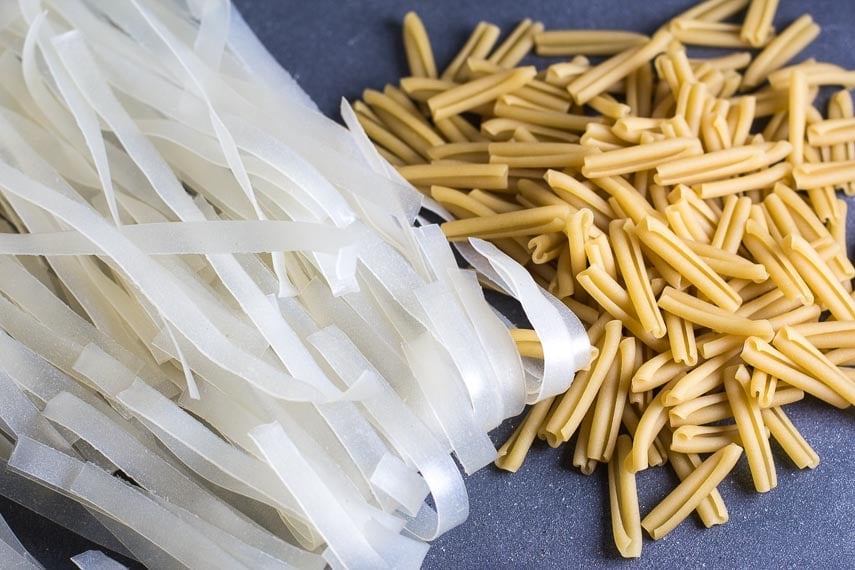
The Jovial pasta (that’s their caserecce on the right above), and brands like it, are re-creating an Italian-style pasta and they look the part!
The ingredients don’t tell the story. As you can see from the image below, the ingredients are the same: rice flour and water. But we all know that they look completely different, whether raw or cooked:
Obviously how the noodles are made is a different process. We like European-style pasta for our capellini and macaroni and cheese, but like the Asian style where called for. As always, we suggest using the pasta that is recommended in individual recipes.
How Do I Know How Much Of The Raw Noodles To Cook?
We think this is a great question. How do you know how much soba to cook, for instance, if the Monash app tells you that you can have 90 g per serving?
First of all, have you ever tried to measure a small volume like ⅓ cup of long, stringy noodles? And secondly, what does 90 g look like? And how much of raw soba do you cook to get 3 ¼-ounces (90 g) cooked?
Test Kitchen Results
I took both soba and pad thai, rice stick type noodles into our Test Kitchen and cooked each of them several times and then notated the average cooked weight. You will see that both types increase in weight considerably when cooked.
Here are the ratios – there is some rounding up and down applied:
Soba
Dry soba increases by a factor of 2.83 when cooked.
Handy soba numbers:
Monash says that a low FODMAP serving size is ⅓ cup (90 g) cooked. You can see the ⅓ cup below; the 90 g of cooked soba was almost double that volume. Please note that we found that this volume was not correct per weight; please use their stated weight in your menu planning.
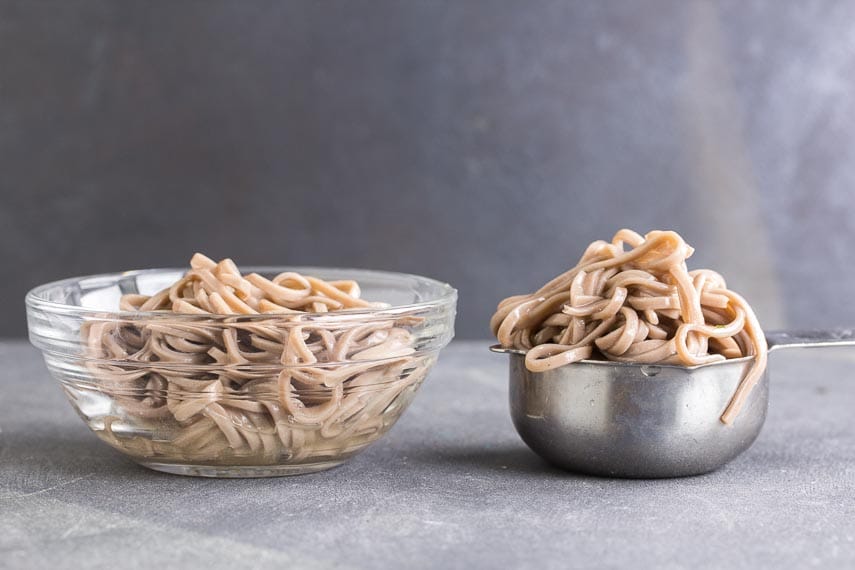
- 1.15-ounces (33 g) of dry soba = 3.25-ounces or 90 g cooked
- 4-ounces (115 g) of dry soba = 11.3-ounces or 324 g cooked
- 6-ounces (170 g) of dry soba noodles = 17-ounces or 482 g cooked
- 8-ounces (225 g) of dry soba noodle = 23-ounces or 652 g cooked
Asian Rice Noodles
For recipes such as our pad thai and steak and noodle salad, you will use Asian-style rice noodles.
Asian rice noodles increase by a factor of 2.63 when cooked.
Handy Asian rice noodle numbers:
Monash says that a low FODMAP serving size is 1 cup (220 g) cooked. You can see the 1 cup below; the 220 g of cooked Asian rice noodles was almost double that volume. Please note that we found that this volume was not correct per weight; please use their stated weight in your menu planning.
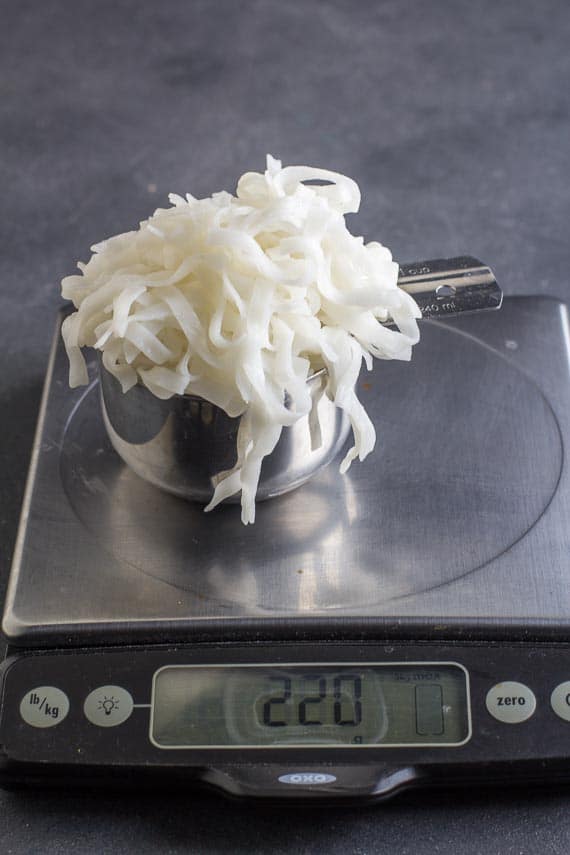
- 2.95-ounces (84 g) of dry Asian rice noodles = 7.75-ounces or 220 g cooked
- 4-ounces (115 g) of dry Asian rice noodles = 10.5-ounces or 300 g cooked
- 6-ounces (170 g) of dry Asian rice noodles = 16-ounces or 455 g cooked
- 8-ounces (225 g) of dry Asian rice noodles = 21-ounces or 595 g cooked
The Takeaway
Many kinds of Asian-style noodles can be incorporated into your low FODMAP lifestyle, even during your Elimination Phase. We suggest that you use this article, our recipes, and your Monash and FODMAP Friendly apps to make smart choices in your Asian-style cooking. You can stay symptom-free, while eating deliciously!
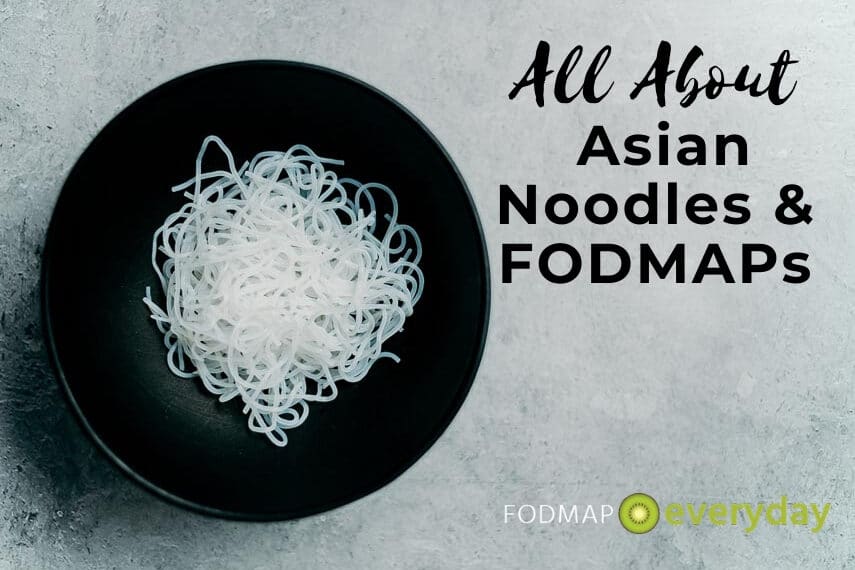
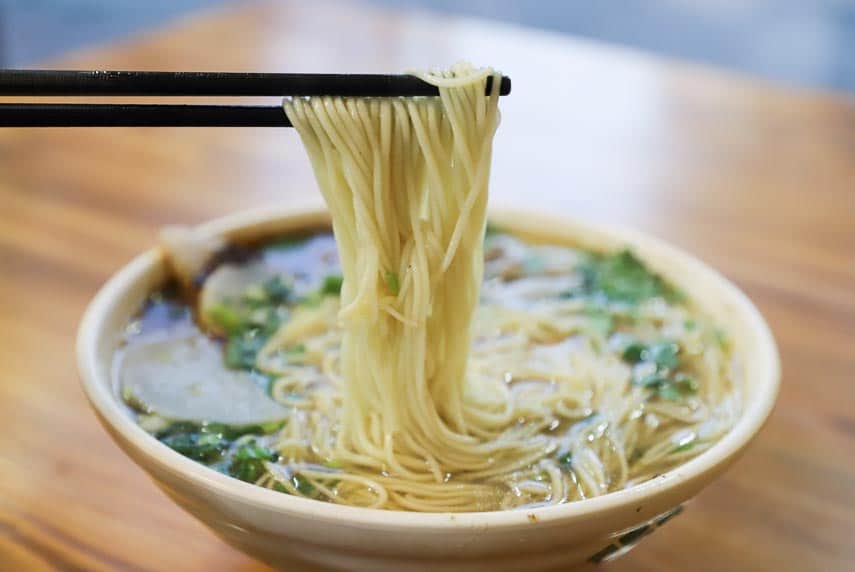
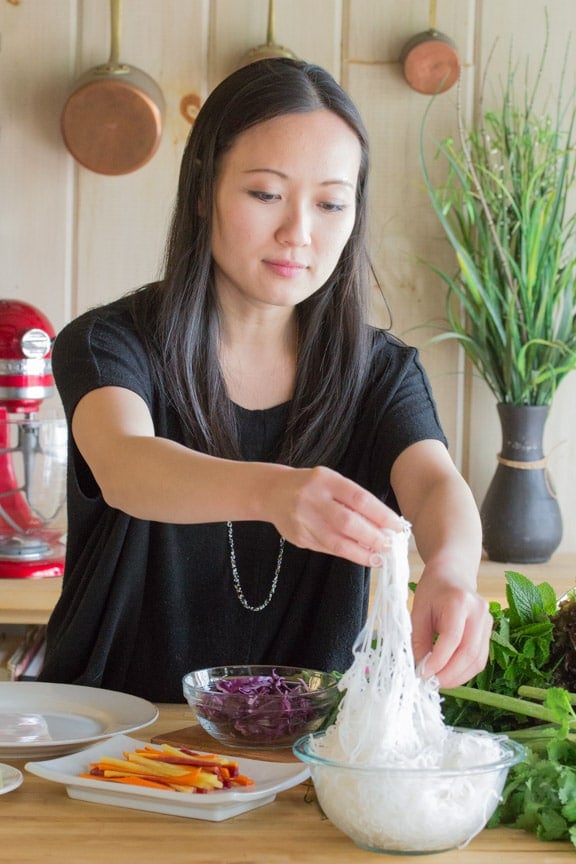
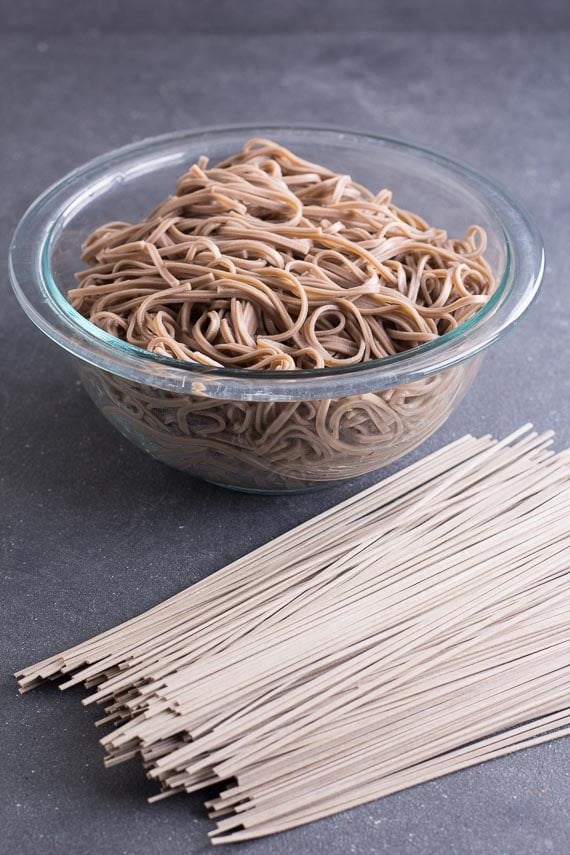
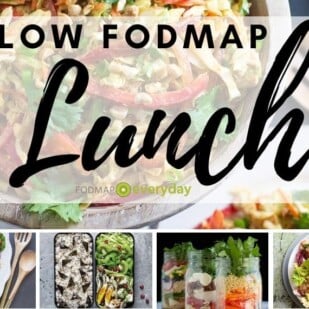
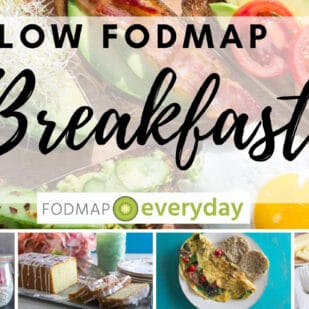






This article has a fatal flaw. You are saying that 90g of COOKED Soba is the maximum amount that is low FODMAP, but the Monash FAQs state: “The serving sizes are the raw weights, unless otherwise specified. For example, when you click into pasta or rice it will say 1 cup, cooked.”
I’m looking at the listing now and none of the following state they are the cooked weight – Noodles/wheat, Noodles/kelp, Noodles/rice stick, Noodles vermicelli/Mung bean and Soba noodles (made from wheat and buckwheat). So we must assume they are the raw weight according to their FAQs.
Only Noodles, vermicelli, sweet potato specifies cooked weight (mine are filtered to UK products so you might have more items than I see).
Are you right, or is Monash? I hope it’s Monash!
Monash is not consistent (that is the biggest flaw, in my mind). We have had personal conversations with them about certain app listings that appeared inconsistent; this was one of them. The information in our article is correct, according to Monash. So we are both right. 🙂
Ugh oh gosh my phone made auto correct errors. Lemme try again, sorry:
I think you should know that while konjac noodles are low fodmap, they are high fiber. With IBS, certain fiber origins can cause different reactions in different guts. For example, I can tolerate psyllium, but not kiwis, which are highly touted for fiber and fodmap friendly (https://www.monashfodmap.com/blog/two-kiwi-fruit-day-keep-constipation-bay/).
A doctor acknowledged this phenomenon and said to just try to find a fiber source that doesn’t give you a bad reaction.
My point in writing this is that konjac gave me the worst reaction I’ve ever had. It was so horrible, I had to make a doctor’s appointment for medication because my guts would not stop. I was concerned about hospitalization over diarrhea from electrolyte loss, but I was able to get into the doctor’s office in time. (I didn’t even have very much…)
(I tried kiwi after medicine, so it gave me a horrible reaction as well but nothing like konjac because it was already managed.)
My father, who did not have IBS or any digestive disorders, also suffered immensely from konjac as a fiber source (he did not take it in excess). We had read about how good it was and he bought some powder, and I got some miracle noodles.
His guts were “messed up” for about three weeks after having the konjac — he doesn’t suffer from IBS.
To my knowledge, we do not have an allergy to this food — it’s just that some fiber sources cause bad reactions in people.
Livestrong warns it could be the combination of FODMAPs: https://www.livestrong.com/article/149231-side-effects-of-konjac-root/
However I agree also with the doctor who said that some people do not tolerate certain sources of fiber.
This is especially sensitive for IBS sufferers who react more strongly to subjectively intolerable fiber sources.
So… maybe put a warning or something about fiber sources, high fiber products, etc.
Thanks.
(Otherwise, I wish I could eat konjac…)
Hi, thank you for writing. we are well aware of what you have pointed out. We focus on what we can eat and what is low FODMAP. There are many low FODMAP foods that can trigger IBS symptoms and digestive distress, for a large variety of reasons. We would have to have warnings here, there and everywhere. I am so sorry you experienced what you did, and your father. This is a great example of why the diet is meant to be undertaken along with a Registered Dietitian. The diet developers always intended that, and yet, so many try to go it alone. It is a medically directed diet and not always smooth sailing.
Thanks for the meticulously researched article. Really helps.